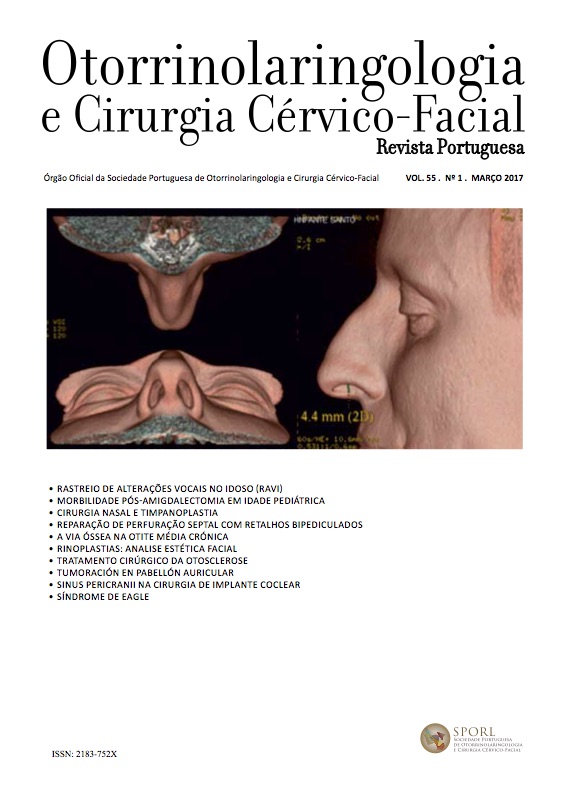Otosclerosis surgery in a residency training program: The Oporto Hospital Center experience
DOI:
https://doi.org/10.34631/sporl.654Keywords:
stapes surgery, otosclerosis, residency training programAbstract
Objective: To evaluate the results of patients submitted to surgical treatment of otosclerosis by residentes of Otorhinolaryngology and to make a reflection on the inclusion of stapedic surgery in the residency program of Otorhinolaryngology.
Materials and Methods: Retrospective study of patients submitted to surgical treatment of otosclerosis, by inpatients of Otorhinolaryngology, at the Oporto Hospital Center between January 2010 and December 2015.
Results: 87 patients were included in the study, and 12 underwent bilateral surgery (performed by residents), in a total of 99 surgical procedures. The surgical success rate was 85% (air-bone gap less than 10dB). The air-bone gap was less than or equal to 20 dB in 96% of the cases. There was only one case of profound sensorineural hearing loss.
Conclusions: After analyzing the literature and evaluating the results and complications obtained in this study, the authors consider that the stapes surgery can be included in the residency training program of the Otorhinolaryngology.
Downloads
References
Rudic M, Keogh I, Wagner R, Wilkinson E, Kiros N, Ferrary E, et al. The pathophysiology of otosclerosis: Review of current research. Hear Res. 2015;330(Pt A):51-6.
Thomas JP, Minovi A, Dazert S. Current aspects of etiology, diagnosis and therapy of otosclerosis. Otolaryngol Pol. 2011;65(3):162-70.
Vincent R, Sperling NM, Oates J, Jindal M. Surgical findings and long-term hearing results in 3,050 stapedotomies for primary otosclerosis: a prospective study with the otology-neurotology database. Otol Neurotol. 2006;27(8 Suppl 2):S25-47.
Hughes GB. The learning curve in stapes surgery. Laryngoscope. 1991;101(12 Pt 1):1280-4.
Burns JA, Lambert PR. Stapedectomy in residency training. Am J Otol. 1996;17(2):210-3.
Vernick DM. Stapedectomy results in a residency training program. Ann Otol Rhinol Laryngol. 1986;95(5 Pt 1):477-9.
Coker NJ, Duncan NO, Wright GL, Jenkins HA, Alford BR. Stapedectomy trends for the resident. Ann Otol Rhinol Laryngol. 1988;97(2 Pt 1):109-13.
Committee on Hearing and Equilibrium guidelines for the evaluation of results of treatment of conductive hearing loss. AmericanAcademy of Otolaryngology-Head and Neck Surgery Ffoundation, Inc. Otolaryngol Head Neck Surg. 1995;113(3):186-7.
Handley GH, Hicks JN. Stapedectomy in residency--the UAB experience. Am J Otol. 1990;11(2):128-30.
Shapira A, Ophir D, Marshak G. Success of stapedectomy performed by residents. Am J Otolaryngol. 1985;6(5):388-91.
Engel TL, Schindler RA. Stapedectomy in residency training. Laryngoscope. 1984;94(6):768-71.
House HP, Hansen MR, Al Dakhail AA, House JW. Stapedectomy versus stapedotomy: comparison of results with long-term follow-up. Laryngoscope. 2002;112(11):2046-50.
Freitas VA, Becker CG, Guimarães RE, Crosara PF, Morais GA, Moura M. Surgical treatment of otosclerosis in medical residency training. Braz J Otorhinolaryngol. 2006;72(6):727-30.
Backous DD, Coker NJ, Jenkins HA. Prospective study of resident-performed stapedectomy. Am J Otol. 1993;14(5):451-4.
Caldart AU, Terruel I, Enge DJ, Kurogi AS, Buschle M, Mocellin M. Stapes surgery in residency: the UFPR clinical hospital experience. Braz J Otorhinolaryngol. 2007;73(5):647-53.
Mathews SB, Rasgon BM, Byl FM. Stapes surgery in a residency training program. Laryngoscope. 1999;109(1):52-3.
Sargent EW. The learning curve revisited: stapedotomy. Otolaryngol Head Neck Surg. 2002;126(1):20-5.
Chandler JR, Rodriguez-Torro OE. Changing patterns of otosclerosis surgery in teaching institutions. Otolaryngol Head Neck Surg. 1983;91(3):239-45.
Manu P, Lane TJ, Matthews DA. How much practice makes perfect? A quantitative measure of the experience needed to achieve procedural competence. Med Teach. 1990;12(3-4):367-9.
Morrison AW. Diseases of the otic capsule–I Otosclerosis. Scott-Brown's diseases of the ear, nose and throat. 1979;2:405-64.
Feldman LS, Cao J, Andalib A, Fraser S, Fried GM. A method to characterize the learning curve for performance of a fundamental laparoscopic simulator task: defining "learning plateau" and "learning rate". Surgery. 2009;146(2):381-6.






